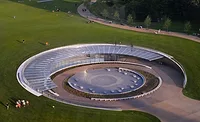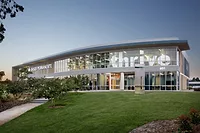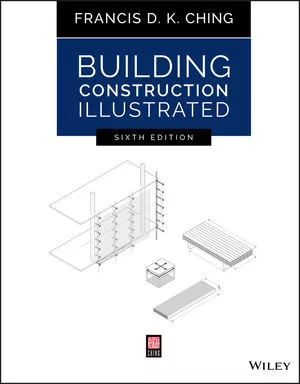accel-E Wall System Helps HRDC Headquarters Earn LEED Gold Certification
The recently completed headquarters facility for the Human Resources Development
Commission of Allegany County has been awarded LEED Gold certification, thanks
in part to its highly energy efficient accel-E Steel Thermal Efficient
Panel (S.T.E.P.) wall system.
PITTSBURGH, Pa. – The recently completed headquarters facility for the Human Resources Development Commission of Allegany County has been awarded LEED Gold certification, thanks in part to its highly energy efficient accel-E Steel Thermal Efficient Panel (S.T.E.P.) wall system.
The LEED Gold certification was presented in late May at a ceremony attended by HRDC officials and others involved in the design and construction of the 20,000-sqauare-foot building, which was completed in November 2009. Those attending included representatives of the U.S. Green Building Council, which developed and administers the LEED program; Moshier Studio of Pittsburgh, the architecture firm that designed the facility; and SYNTHEON Inc., which manufactures the accel-E wall system.
“When we began designing our building we decided we would attempt to build a building that had at least a LEED Gold certification,” said Dan Lewellen, deputy director of the HRDC. “The accel-E wall panel system was one of the factors that helped us garner LEED points and achieve that goal.”
The LEED (Leadership in Energy & Environmental Design) green building rating system was developed by the USGBC to provide third-party verification that a building was designed and built using strategies that improve performance and long-term sustainability in several key areas including energy efficiency, indoor environmental quality and overall environmental impact. “The accel-E system was part of a coordinated approach that included a planted roof, ground source heat pump and other factors,” Lewellen explained. “The system forms part of an energy conservation package that has allowed us to realize those savings and achieve LEED Gold designation.”
In addition to improving long-term sustainability, the use of energy-saving technology has also produced more immediate and tangible benefits, he added. Those benefits became apparent when a review of the building’s performance as part of the LEED commissioning project revealed significant savings in energy and other utility costs.
“In a conventionally built building, the mixed-use utility costs for gas, water and electric in a building such as ours typically run about $3.15 or $3.16 per square foot, on an annualized basis,” Lewellen explained. “But after a year of occupancy we found our costs were running at about $2.15 or $2.16.
“So while there was a little more front-end investment in some of these systems, there’s a pretty rapid return on that investment, particularly when you’re saving a third on your utility costs,” he added.
The accel-E wall system achieves its excellent energy efficiency by fusing cold-formed steel framing components and expandable polystyrene (EPS) insulating panels together into a single continuous system. This eliminates air gaps, reduces thermal bridging and heat transference, blocks air intrusion, and adds thermal resistance. As a result, the accel-E panel’s offer tested insulating values that far surpass other panel systems and traditional framing techniques. “In addition to helping reduce energy costs for heating and cooling, the accel-E wall system is also very ‘green’ in terms of it long-term environmental impact,” said Jeff Peskowitz, SYNTHEON’s director of marketing. He noted that the wall system contributes points to as many as four LEED categories.
The accel-E steel framing members are made of recycled steel and are themselves recyclable. In addition, the EPS foam insulation does not shrink, settle, emit harmful VOC gases, or contribute to diminished air quality. Moreover, replacing conventional framing and insulation with pre-engineered accel-E panels virtually eliminates jobsite waste and disposal issues – all of which further contribute to the system’s LEED points.
Ultimately, the advantages of any new building system are measured in how well it meets the needs of its occupants. By that measure, the new facility with its accel-E wall system is clearly successful, according to Lewellen.
“LEED Gold means the occupants’ satisfaction with their surroundings is higher, and you just have a cleaner environment for people to work in,” he said, pointing out that the 160-employee nonprofit community action agency administers 19 separate programs aimed at improving the lives of the young, poor, elderly and disabled throughout Allegany County.
”This building allowed us to consolidate four other separate sites under one roof, so we could create more of a one-stop shop for the people we serve,” he added.
The accel-E system fully complies with both the 2006 International Building Code (IBC) and the 2006 International Residential Code (IRC). The panels’ effective R-Value and U-Factor exceed ASHRAE 90.1 2007 and IECC 2009 Energy Code requirements for cavity plus continuous insulation in steel stud wall assemblies for all climate zones. For more information, please visit www.accel-E.com.
PITTSBURGH, Pa. – The recently completed headquarters facility for the Human Resources Development Commission of Allegany County has been awarded LEED Gold certification, thanks in part to its highly energy efficient accel-E Steel Thermal Efficient Panel (S.T.E.P.) wall system.
The LEED Gold certification was presented in late May at a ceremony attended by HRDC officials and others involved in the design and construction of the 20,000-sqauare-foot building, which was completed in November 2009. Those attending included representatives of the U.S. Green Building Council, which developed and administers the LEED program; Moshier Studio of Pittsburgh, the architecture firm that designed the facility; and SYNTHEON Inc., which manufactures the accel-E wall system.
“When we began designing our building we decided we would attempt to build a building that had at least a LEED Gold certification,” said Dan Lewellen, deputy director of the HRDC. “The accel-E wall panel system was one of the factors that helped us garner LEED points and achieve that goal.”
The LEED (Leadership in Energy & Environmental Design) green building rating system was developed by the USGBC to provide third-party verification that a building was designed and built using strategies that improve performance and long-term sustainability in several key areas including energy efficiency, indoor environmental quality and overall environmental impact. “The accel-E system was part of a coordinated approach that included a planted roof, ground source heat pump and other factors,” Lewellen explained. “The system forms part of an energy conservation package that has allowed us to realize those savings and achieve LEED Gold designation.”
In addition to improving long-term sustainability, the use of energy-saving technology has also produced more immediate and tangible benefits, he added. Those benefits became apparent when a review of the building’s performance as part of the LEED commissioning project revealed significant savings in energy and other utility costs.
“In a conventionally built building, the mixed-use utility costs for gas, water and electric in a building such as ours typically run about $3.15 or $3.16 per square foot, on an annualized basis,” Lewellen explained. “But after a year of occupancy we found our costs were running at about $2.15 or $2.16.
“So while there was a little more front-end investment in some of these systems, there’s a pretty rapid return on that investment, particularly when you’re saving a third on your utility costs,” he added.
The accel-E wall system achieves its excellent energy efficiency by fusing cold-formed steel framing components and expandable polystyrene (EPS) insulating panels together into a single continuous system. This eliminates air gaps, reduces thermal bridging and heat transference, blocks air intrusion, and adds thermal resistance. As a result, the accel-E panel’s offer tested insulating values that far surpass other panel systems and traditional framing techniques. “In addition to helping reduce energy costs for heating and cooling, the accel-E wall system is also very ‘green’ in terms of it long-term environmental impact,” said Jeff Peskowitz, SYNTHEON’s director of marketing. He noted that the wall system contributes points to as many as four LEED categories.
The accel-E steel framing members are made of recycled steel and are themselves recyclable. In addition, the EPS foam insulation does not shrink, settle, emit harmful VOC gases, or contribute to diminished air quality. Moreover, replacing conventional framing and insulation with pre-engineered accel-E panels virtually eliminates jobsite waste and disposal issues – all of which further contribute to the system’s LEED points.
Ultimately, the advantages of any new building system are measured in how well it meets the needs of its occupants. By that measure, the new facility with its accel-E wall system is clearly successful, according to Lewellen.
“LEED Gold means the occupants’ satisfaction with their surroundings is higher, and you just have a cleaner environment for people to work in,” he said, pointing out that the 160-employee nonprofit community action agency administers 19 separate programs aimed at improving the lives of the young, poor, elderly and disabled throughout Allegany County.
”This building allowed us to consolidate four other separate sites under one roof, so we could create more of a one-stop shop for the people we serve,” he added.
The accel-E system fully complies with both the 2006 International Building Code (IBC) and the 2006 International Residential Code (IRC). The panels’ effective R-Value and U-Factor exceed ASHRAE 90.1 2007 and IECC 2009 Energy Code requirements for cavity plus continuous insulation in steel stud wall assemblies for all climate zones. For more information, please visit www.accel-E.com.
Looking for a reprint of this article?
From high-res PDFs to custom plaques, order your copy today!





